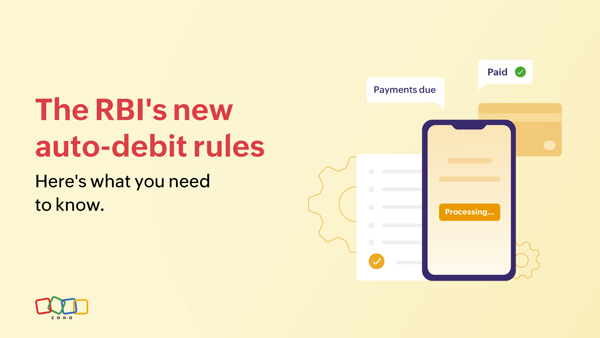- HOME
- Payment collection and compliance
- The RBI's new auto-debit rules - Here's what you need to know
The RBI's new auto-debit rules - Here's what you need to know
Subscribing for a service used to be easy. Businesses could auto-debit payments so customers wouldn't have to go through the hassle of remembering to pay at the end of every cycle. This was especially convenient since the business could ensure that they were paid on time, and the customer could enjoy their subscription in peace. However, this level of simplicity naturally came with some issues. Customers had no transparency with their transactions; they didn't have the option to see what services they had subscribed to, nor did they have much control over these recurring transactions.

In order to simplify service subscriptions for users, the RBI came up with auto-debit rules, which they released on October 1st of last year.
The RBI's new auto-debit rules
With the RBI’s new auto-debit rules, all customers who are interested in setting up recurring payments or e-mandates via credit or debit card must first go through a mandatory one-time registration process to register their card(s). Customers are then required to provide authorization through additional factor authentication (AFA), in the form of an OTP. Next is the actual payment itself.
For transaction amounts less than Rs. 15,000: Once the one-time registration process with AFA has been completed, all payments worth less than Rs. 5,000 can be auto-debited provided a notification is sent 24 hours prior to each transaction via email or SMS. This final notification is just to inform the customer of the transaction and does not require any action.
For transaction amounts worth Rs. 15,000 or more: In addition to the one-time registration process with AFA, transactions worth Rs. 5,000 or more require an AFA (OTP) for every transaction. Therefore, these transactions cannot be auto-debited. Customers must also be sent a notification 24 hours prior to each transaction via email or SMS, which will come with a link that they'll need to open to initiate the authorization process.
At any point during these processes, customers can choose to pause, revoke, and resume the e-mandate using a relevant link that’s attached to the payment notification. These rules aim to give them more control over their transactions.
Impact on businesses
While the rules have been welcomed by a majority of customers, complying to these rules has been a bit of a challenge for most businesses that collect recurring payments since it requires them to rethink and change their workflows. Among the affected businesses are SaaS companies, local and international subscription-based media outlets, and Big Tech companies (i.e. Amazon, Apple, Google, Facebook, Netflix, and Twitter).
Short-term impact
Although some banks have become compliant with these new rules, at the time the mandate was released, most payment gateway providers hadn't onboarded banks to their platform. Therefore, until this step had been completed, businesses could not auto-debit payments from their customers.
This compliance delay has resulted in a high amount of involuntary churn. Businesses cannot make auto-debits anymore, and customers assume that their payment is being collected automatically so they don't pay manually either. Eventually, the customer's account is cancelled after a prolonged period of no payments. To prevent this churn, businesses are forced to offer free trials or move customers to an annual billing plan to reduce the overhead costs on sales follow-up.
Long-term impact (When all gateway providers are compliant)
There may not be much room for flexibility while autocharging e-mandates since the rules don't allow service providers to charge customers as soon as the service has been amended. Examples of such scenarios are cases of upgrades or add-on purchases that happen in the middle of a billing cycle. Customers may need to set up a new e-mandate all over again.
Takeaways
What can businesses do?
Despite these challenges, all hope is not lost—there are other ways to collect recurring payments. eNACH and UPI AutoPay are examples of alternatives that businesses can use.
What can the RBI do?
It would be beneficial if the new regulations allowed customers themselves to set an upper transaction limit for auto-debit (which is currently Rs. 15,000), against each merchant. With such a system, customers can have the flexibility to sign up for a different plan with each company they purchase from based on their requirements. In turn, businesses can continue to auto-debit payment. This is similar to the system followed by banks while making fund transfers or NEFT payments. For instance, a customer would be able to set the transaction limit as Rs. 15,000 while purchasing from Business A, and then increase it to Rs.20,000 while purchasing from Business B. In both cases, the business would be able to auto-debit its payment.
Another suggestion would be for the new system to support ad-hoc charges in addition to the regular renewal payments. This is especially useful for SaaS businesses that follow user-based pricing models, where there are frequent additions and removals of users that require adjustments to prorated ad-hoc charges.
